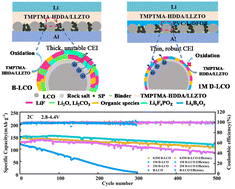Bilayer electrolyte design toward high-voltage durable solid-state lithium metal batteries†
Abstract
To obtain higher energy density, the choice of LiCoO2 (LCO) with extraordinary theoretical volumetric energy density as the cathode has absolute advantages, and more discharge capacity can be obtained by increasing the cut-off voltage. However, several challenges, including surface degradation, irreversible structural transformation, cobalt dissolution, and detrimental side reactions with electrolyte, arise when charging to a high cut-off voltage (>4.2 V vs. Li/Li+), which lead to rapid capacity decay. Herein, we constructed poly(vinyl carbonate) (PVC)/lithium difluoro(oxalato) borate (LiDFOB) interface layer on the surface of LCO by artificial design, aiming at the interface between Li6.4La3Zr1.4Ta0.6O12 (LLZTO)-based composite electrolyte and LCO. The electrode plate is composed of 1 M LiDFOB/VC and LCO cathode (named as 1 M D-LCO). A B–F/LiF-rich cathode electrolyte interphase (CEI) layer is formed during electrochemical cycling, which effectively suppresses the side reactions between LCO and electrolyte under high voltage and improves the interfacial stability. As a result, the 1 M D-LCO|trimethylolpropane trimethacrylate (TMPTMA)-1,6-hexanediol diacrylate (HDDA)/LLZTO|Li cell delivers an initial discharge capacity of 141.2 mA h g−1 at 2C (4.4 V, 83.57% after 500 cycles) and superior high voltage stability (4.6 V, 75.12% after 150 cycles), which is one of the best results for 1 M D-LCO|TMPTMA–HDDA/LLZTO|Li reported to date. This work provides an effective method for the compatibility of cathode and solid-state electrolytes.



 Please wait while we load your content...
Please wait while we load your content...